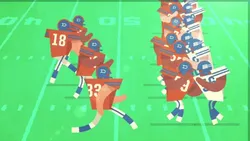
Digital Animation with Experimental Techniques 
Explore the possibilities of digital animation by combining traditional art techniques with experimental methods such as acrylic paint and pastels. Discover how to create unique animations that bridge the physical and digital worlds. ▼
ADVERTISEMENT
Course Feature
![]() Cost:
Cost:
Paid
![]() Provider:
Provider:
Udemy
![]() Certificate:
Certificate:
No Information
![]() Language:
Language:
English
Course Overview
❗The content presented here is sourced directly from Udemy platform. For comprehensive course details, including enrollment information, simply click on the 'Go to class' link on our website.
Updated in [March 06th, 2023]
(Please note the following content is from the official provider.)
Learn how to make an animation in Cinema 4D by experimenting with the various tools for shaping and rendering your design.
Learn how to map out your motion graphic in InDesign before printing.
Then, using your preferred art supplies, add detail to your illustration. Danae explains her creative process as she edits the sequence's texturized images in Photoshop.
Learn how to use After Effects to create a seamless animation by cleaning your frames and correcting the colour.
Investigate the software's tools for creating a crisp motion graphic and bringing your design to life.
Finish the course by learning how to properly export your animation and share it with the rest of the world.
(Please note that we obtained the following content based on information that users may want to know, such as skills, applicable scenarios, future development, etc., combined with AI tools, and have been manually reviewed)
Digital Animation with Experimental Techniques is a great course for learners to explore the creative possibilities of animation. Through this course, learners will gain an understanding of the fundamentals of animation, such as mapping out motion graphics in InDesign, adding detail to illustrations in Photoshop, and creating a crisp motion graphic in After Effects. Learners will also learn how to use Cinema 4D to shape and render their designs, as well as how to export and share their animations with the world. This course is perfect for those who are interested in exploring the creative possibilities of animation and want to learn how to create their own unique animations.
[Applications]
Students who have completed this course will be able to apply their knowledge of digital animation with experimental techniques to create their own motion graphics. They will be able to use Cinema 4D to shape and render their designs, InDesign to map out their motion graphics, and Photoshop to edit their texturized images. They will also be able to use After Effects to clean their frames, correct the colour, and create a crisp motion graphic. Finally, they will be able to export their animation and share it with the world.
[Career Paths]
1. Digital Animator: Digital animators create animations for video games, movies, television shows, and other digital media. They use a variety of software programs to create characters, backgrounds, and other elements of the animation. They also work with directors and producers to ensure that the animation meets the desired specifications. The demand for digital animators is increasing as the use of animation in media continues to grow.
2. Motion Graphics Designer: Motion graphics designers create animations for websites, television commercials, and other digital media. They use a variety of software programs to create motion graphics, such as After Effects, Cinema 4D, and Adobe Premiere Pro. They also work with directors and producers to ensure that the animation meets the desired specifications. The demand for motion graphics designers is increasing as the use of animation in media continues to grow.
3. 3D Modeler: 3D modelers create 3D models for video games, movies, television shows, and other digital media. They use a variety of software programs to create characters, backgrounds, and other elements of the 3D model. They also work with directors and producers to ensure that the model meets the desired specifications. The demand for 3D modelers is increasing as the use of 3D models in media continues to grow.
4. Visual Effects Artist: Visual effects artists create special effects for movies, television shows, and other digital media. They use a variety of software programs to create realistic effects, such as explosions, fire, and water. They also work with directors and producers to ensure that the effects meet the desired specifications. The demand for visual effects artists is increasing as the use of special effects in media continues to grow.
[Education Paths]
1. Bachelor of Arts in Animation: This degree program provides students with the skills and knowledge necessary to create animation for film, television, video games, and other media. Students learn the fundamentals of animation, including character design, storyboarding, and 3D modeling. They also learn about the history and theory of animation, as well as the latest software and techniques used in the industry. This degree program is ideal for those interested in pursuing a career in animation or related fields.
2. Master of Fine Arts in Animation: This degree program is designed for those who want to take their animation skills to the next level. Students learn advanced techniques in 3D modeling, character design, and motion graphics. They also explore the history and theory of animation, as well as the latest software and techniques used in the industry. This degree program is ideal for those interested in pursuing a career in animation or related fields.
3. Bachelor of Science in Computer Animation: This degree program provides students with the skills and knowledge necessary to create animation for film, television, video games, and other media. Students learn the fundamentals of computer animation, including 3D modeling, character design, and motion graphics. They also learn about the history and theory of animation, as well as the latest software and techniques used in the industry. This degree program is ideal for those interested in pursuing a career in animation or related fields.
4. Master of Science in Computer Animation: This degree program is designed for those who want to take their animation skills to the next level. Students learn advanced techniques in 3D modeling, character design, and motion graphics. They also explore the history and theory of animation, as well as the latest software and techniques used in the industry. This degree program is ideal for those interested in pursuing a career in animation or related fields. With the increasing demand for animation in the entertainment industry, the demand for skilled animators is also increasing. As a result, the job market for animators is expected to grow in the coming years.
Course Syllabus
Preparing the Materials
My Creative Process
Collecting References
Course Provider

Provider Udemy's Stats at AZClass
Discussion and Reviews
0.0 (Based on 0 reviews)
Explore Similar Online Courses

IELTS Reading Section Skills Mastery

Teaching Online: Mindset & Strategies For Instructor Success

Python for Informatics: Exploring Information

Social Network Analysis

Introduction to Systematic Review and Meta-Analysis

The Analytics Edge

DCO042 - Python For Informatics

Causal Diagrams: Draw Your Assumptions Before Your Conclusions

Whole genome sequencing of bacterial genomes - tools and applications

Simple Character Animation

Introduction to Cinema 4D: A Beginner& Animation Guide

Expressive Animation: Combining Photoshop Illustrator and After Effects
 Related Categories
Related Categories
 Popular Providers
Popular Providers
 Popular Searches
Popular Searches
Quiz
 Submitted Sucessfully
Submitted Sucessfully
1. What software is used to create a seamless animation?
2. What is the purpose of mapping out a motion graphic in InDesign?
3. What is the final step of the course?
4. What is the main focus of the course?


Start your review of Digital Animation with Experimental Techniques